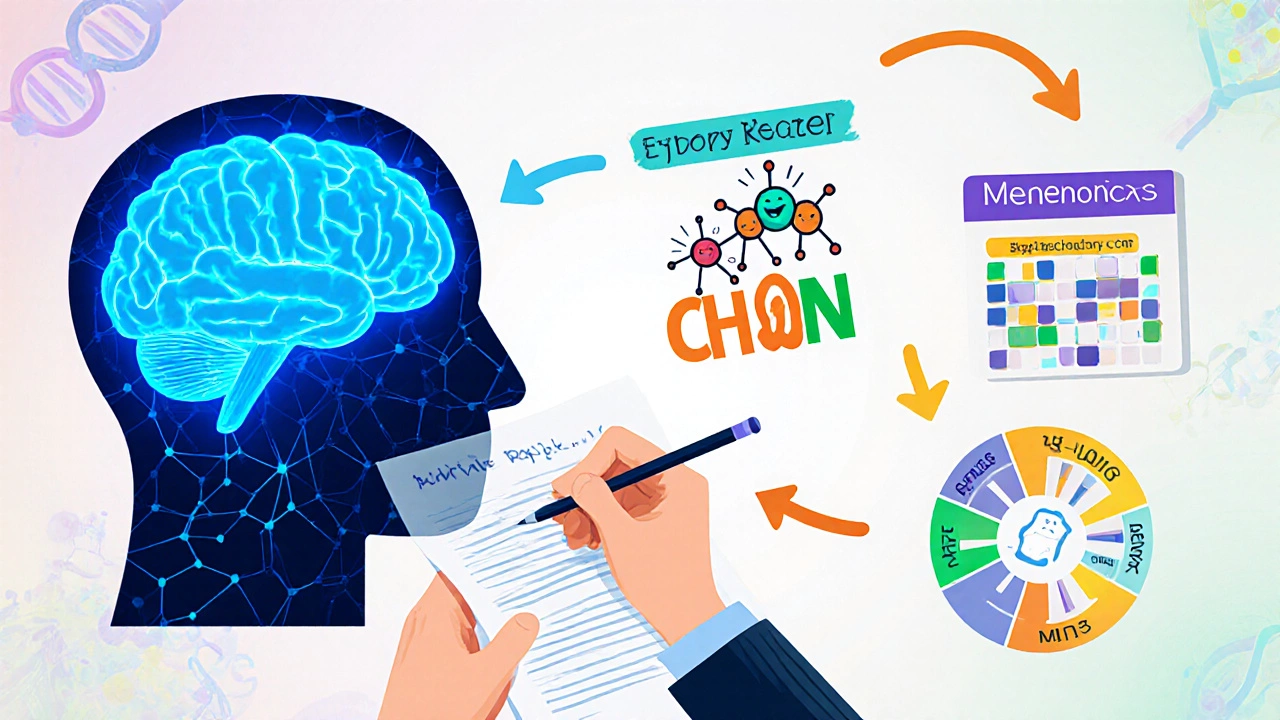Spaced Repetition Scheduler
Optimize Your NEET Study Schedule
Calculate ideal review intervals based on cognitive science principles from the article
Why This Matters
Research shows spaced repetition boosts NEET exam retention by 50-70%. This tool calculates optimal review intervals based on the forgetting curve principles from the article.
Your Spaced Repetition Schedule
Retention Estimate: 90% retention after 7 days with consistent review.
Key Recommendations
When tackling the NEET is a national medical entrance exam in India that tests knowledge in Physics, Chemistry, and Biology, speed is everything. Aspirants often ask, “What is the fastest way to memorize NEET?” The answer lies in a mix of science‑backed memory methods, smart scheduling, and the right tools.
Quick Takeaways
- Use active recall and spaced repetition for long‑term retention.
- Turn dense NCERT facts into mnemonics or mind maps.
- Leverage digital flashcard apps like Anki to automate spaced repetition.
- Study in 25‑minute Pomodoro blocks with short breaks to keep focus.
- Follow a weekly checklist to ensure coverage of all three NEET subjects.
Understanding the Memory Challenge
NEET covers three major subjects, each with its own volume of facts. Biology alone includes over 1,200 definitions, 800 pathways, and countless diagrams. Physics and Chemistry bring formulas, reaction mechanisms, and problem‑solving steps. The brain’s natural limitation is remembering new information for only a few days without reinforcement. That’s why the "fastest" way isn’t about cramming-it’s about encoding knowledge in a way that survives the forgetting curve.
Core Memory Principles You Need to Know
Two concepts form the foundation of any rapid‑memorization plan:
- Active Recall: Pulling information from memory rather than re‑reading it.
- Spaced Repetition: Reviewing material at increasing intervals to cement it.
Both techniques have been validated by cognitive psychologists and are the backbone of the most effective NEET study regimes.
Technique 1: Active Recall - Test Yourself Early
The moment you finish a chapter, close the book and write down everything you remember. Use short answer questions, flashcards, or explain concepts aloud to a study partner. This forces the brain to retrieve the material, strengthening neural pathways.
For example, after reading the NCERT chapter on the Cardiovascular System, try to list all the blood vessels involved without looking. If you stumble, review that specific part and test again. Repeating this process daily cuts the time needed to move information from short‑term to long‑term memory.
Technique 2: Spaced Repetition - Review at the Right Intervals
The Spaced Repetition algorithm schedules reviews just before you’re about to forget. Most students start with a 1‑day, 3‑day, 7‑day, and 14‑day cycle.
Set up a digital deck in Anki (or a free alternative like Quizlet). Input facts as Q‑A pairs, then let the app handle the timing. Studies show a 50‑70% increase in retention compared to traditional rereading.

Technique 3: Mnemonics - Make It Stick
Mnemonics turn abstract data into vivid, easy‑to‑remember images or phrases. For Chemistry, the classic “CHON” mnemonic helps recall the four most common elements in organic compounds: Carbon, Hydrogen, Oxygen, Nitrogen.
In Biology, create a story linking the steps of the Krebs cycle. The more bizarre or emotional the story, the stronger the memory trace.
Technique 4: Mind Maps - Visual Organizers
Instead of linear notes, draw mind maps that branch out from a central concept. A Physics mind map for Electromagnetism could start with “Maxwell’s Equations” at the center, then branch into “Gauss’s Law,” “Faraday’s Law,” etc., each with a tiny sketch of the related field lines.
Mind maps leverage visual memory, which is often faster than pure text recall. Spend 10‑15 minutes after each study session to convert notes into a map.
Technique 5: Pomodoro + Strategic Breaks
The Pomodoro Technique-25 minutes of focused study followed by a 5‑minute break-helps maintain high concentration. After four Pomodoros, take a longer 15‑30 minute break to walk, stretch, or hydrate.
During breaks, avoid screen time. A quick walk boosts blood flow to the brain, enhancing consolidation of what you just learned.
Building a Weekly Study Schedule
Combine the above methods into a repeatable weekly plan. Here’s a sample structure:
- Monday: Biology (Active Recall + Mind Map) - 2 Pomodoros.
- Tuesday: Chemistry (Mnemonics + Spaced Review) - 2 Pomodoros.
- Wednesday: Physics (Problem Solving + Active Recall) - 2 Pomodoros.
- Thursday: Mixed Mock Test (30‑minute timed session) - Review errors with Active Recall.
- Friday: Review all flashcards in Anki (Spaced Repetition) - 1‑hour session.
- Saturday: Full‑length NEET practice paper - Analyze performance.
- Sunday: Light revision, mind‑map updates, and rest.
This rotation ensures each subject gets focused attention while also reinforcing previous material.

Tools & Resources You Can Use Today
Below is a quick comparison of popular study aids. Choose the ones that fit your learning style.
| Technique | Time to Implement | Retention Boost (approx.) | Best for Subject |
|---|---|---|---|
| Active Recall | 5min per topic | +45% | All subjects |
| Spaced Repetition (Anki) | 30min setup | +70% | Biology facts, Chemistry formulas |
| Mnemonics | 10min per concept | +30% | Chemistry elements, Biology pathways |
| Mind Maps | 15min per chapter | +35% | Physics concepts, Biology systems |
| Pomodoro | Instant | +20% | All subjects (focus) |
Checklist: Daily NEET Memorization Routine
- ✅ Spend 25min on active recall for the day’s topic.
- ✅ Add new flashcards to Anki and review due cards.
- ✅ Create at least one mnemonic or mind‑map snippet.
- ✅ Follow the Pomodoro timer: 2 cycles for heavy topics, 1 for light review.
- ✅ End with a 5‑minute self‑quiz to gauge retention.
Common Pitfalls and How to Avoid Them
Pitfall 1: Passive rereading - It feels productive but adds almost no retention. Switch to active recall immediately after reading.
Pitfall 2: Ignoring the forgetting curve - Skipping spaced reviews leads to rapid loss. Set daily Anki reminders.
Pitfall 3: Overloading one technique - Relying solely on mnemonics can create shallow understanding. Blend with problem‑solving practice.
Pitfall 4: Long marathon study sessions - Fatigue reduces focus. Keep each session under 45minutes.
Next Steps: Personalize Your Fast‑Track Plan
Start by auditing your current notes. Identify three high‑impact topics you struggle with, then apply the active recall + spaced repetition combo for two weeks. Measure your recall speed with a quick self‑quiz: if you can list 90% of facts in under 2minutes, you’re on the right track.
From there, layer in mnemonics and mind maps for the remaining subjects. Remember, the "fastest" way isn’t a shortcut; it’s a systematic, evidence‑based process that syncs with how your brain naturally learns.
Frequently Asked Questions
How long does it take to see results with spaced repetition?
Most students notice a jump in recall after 7‑10 days of consistent Anki reviews. The key is daily interaction, even if it’s just a few minutes.
Can I use mobile apps without internet?
Yes. Both Anki and Quizlet allow offline decks. Prepare your decks before a commute or a power‑cut.
What’s the ideal number of flashcards per day?
Aim for 30‑40 new cards and review all due cards. Overloading beyond 60 new cards reduces retention.
Do mind maps work for quantitative problems?
They’re best for conceptual links, but you can sketch formula trees that show derivations, which helps during problem solving.
How many Pomodoros should I schedule each day?
Four to six Pomodoros (2-3hours) strike a balance between intensity and fatigue for most NEET aspirants.
